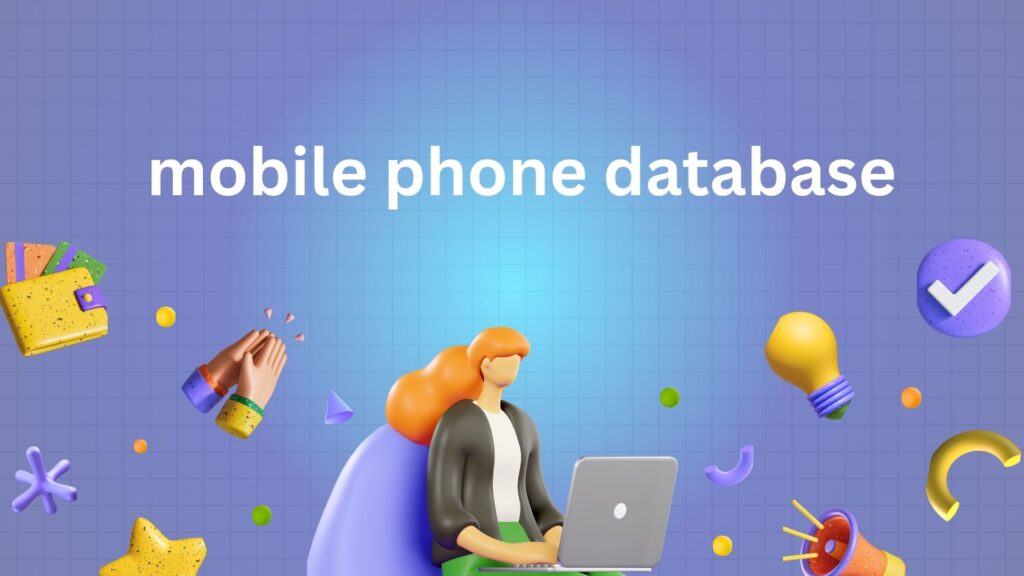Every day, you use your mobile phone for many things. You send messages. You play games. Perhaps you watch videos or check the weather. All these actions create or use information. Where does your phone keep all this information? It uses something called a “mobile phone database.” Think of a database like a very organized digital filing cabinet. It stores your phone’s important data in a way that is easy to find, change, and use. Indeed, without these databases, your phone apps would not work well.
Imagine you have a phone book made of paper. All your friends’ names and numbers are listed. This is a simple database. A mobile phone database is much like that. However, it is far more powerful. It holds many types of information. It keeps track of app settings, your contacts, messages, and even game scores. Therefore, databases are key to how your phone operates.
Mobile databases help your phone work even when there is no internet. For example, you can still see your saved contacts. You can also read old messages. This is because the data is stored right on your device. When you get back online, your phone might update this data. This makes sure everything is fresh and correct.
Why are Databases Needed on Phones?
Think about all the apps on your phone. Each app needs latest mailing database a place to keep its own information. A game, for instance, needs to remember your progress. A messaging app needs to save your conversations. This is where databases come in handy. They provide a structured way for apps to store and get information. Consequently, your apps run smoothly.
Moreover, databases help keep your phone fast. When data is organized, your phone does not have to search everywhere. It knows exactly where to look. This means apps load quicker. It also means actions happen faster. So, next time your app works instantly, remember the database working behind the scenes.

How Data is Stored Locally
Your phone has different places to store data. Some data photo editing services: everything you need to know is stored in what we call “internal storage.” This is like a private room for each app. Only that app can usually see and use its own data here. For example, your banking app keeps sensitive info here. This helps keep your private details safe from other apps.
Sometimes, data is stored in “external storage.” This can be like an SD card you put in your phone. It is a place where many apps can share information. Pictures and videos are often saved here. You might also find downloaded files in external storage. However, apps need your permission to access this shared space.
The Role of Databases in Offline Use
One great thing about mobile phone databases is how they help with offline use. Imagine you are on an airplane. There is no internet connection. Still, you can open your notes app. You can look at your photos. This is because the data is saved in a database on your phone.
Later, when you connect to the internet, your phone can update. It can send new information to the cloud. It can also download fresh data. This process is called “synchronization.” It makes sure your phone and the cloud have the same, most recent information. Clearly, this is very convenient for users.
Everyday Examples of Mobile Databases
Many apps you use daily rely on mobile databases. Your contacts list is a simple database. Your calendar app uses one to store events. Messaging apps save all your chats in a database. Even your alarm clock app needs a database to remember your settings. All these examples show how essential they are.
Furthermore, fitness trackers often use databases. They store your steps, heart rate, and exercise details. Map apps save maps for offline use in their databases. Clearly, mobile databases are everywhere. They are truly the backbone of modern phone apps.
Different Kinds of Mobile Phone Databases
Just like there are different ways to organize paper files, there are different types of digital databases. Some are like strict tables with rows and columns. Others are more flexible, like a pile of documents that can be easily changed. The type of database used depends on what the app needs.
One common type is called a “relational database.” This is like a set of connected tables. For example, one table might list all your friends. Another table might list their phone numbers. These tables are linked. This makes it easy to find a friend’s number. SQLite is a very popular relational database for phones.
Another type is a “NoSQL database.” This kind is more flexible. It does not use strict tables. Instead, it stores data in different ways. This can be good for information that changes a lot. Or, it can be good for very large amounts of data. MongoDB is an example of a NoSQL database.
SQLite: A Popular Choice
SQLite is a tiny, powerful database. It is built right into many mobile phones. It is also used by a lot of apps. One big reason for its popularity is its size. It does not take up much space. Furthermore, it is very fast. This makes it perfect for mobile devices.
Many Android and iPhone apps use SQLite. It helps them store structured data. For instance, a list of tasks in a to-do app would fit well in SQLite. It is reliable and works even when there is no internet. Therefore, it is a favorite among app makers.
NoSQL Databases for Flexibility
Sometimes, data does not fit neatly into tables. Think about messages in a chat app. They are all different lengths. They might have pictures or emojis. For this kind of data, NoSQL databases are often better. They allow for more flexible ways to store information.
Couchbase Lite and Realm are examples of NoSQL databases. They are good for apps that need to handle different kinds of data. They also work well for apps that need to sync data in real time. This means changes made on one phone show up quickly on another. Clearly, they offer great flexibility.
The Importance of Databases for Mobile Apps
Mobile phone databases are incredibly important for apps. They are the hidden power behind many features we enjoy. Without them, apps would struggle to save information. They would also struggle to work offline. Therefore, databases are truly essential for a good app experience.
A good database helps an app run fast. It also helps it store information safely. Imagine a social media app. It needs to save your posts and comments. It also needs to show you what your friends are doing. A well-designed database makes all this possible. It keeps everything organized and ready.
How Databases Improve App Performance
When an app needs information, it asks the database. If the database is well-organized, it finds the information quickly. This makes the app feel speedy and responsive. Conversely, a messy database would make the app slow. Therefore, good database design is key for performance.
Databases also help manage memory. They ensure that your phone does not run out of space. They store data efficiently. This means your apps use less power. They also run more smoothly. Consequently, your phone lasts longer on a single charge.
Data Security in Mobile Databases
Keeping your data safe is very important. Mobile databases play a big role in this. They can encrypt information. This means they scramble it so only the right app can read it. It is like putting your secrets in a locked box. Only you have the key.
Furthermore, databases can control who sees what. Your banking app, for example, will only let you see your account details. It uses the database to manage these permissions. Therefore, strong security features are built into many mobile databases. This helps protect your personal information.
Challenges and Future of Mobile Databases
While mobile databases are powerful, they also face singapore lead challenges. One challenge is keeping data in sync across many devices. If you use an app on your phone and tablet, both need the same information. Making sure this happens smoothly can be tricky. However, new technologies are always improving this.
Another challenge is data privacy. As more information is stored, it becomes even more important to protect it. Developers must ensure databases are secure. They must also follow rules about how data is used. Clearly, this is a big responsibility.
Looking to the future, mobile databases will become even smarter. They might use artificial intelligence to organize data even better. They will also handle even larger amounts of information. As phones become more powerful, their databases will grow too. Eventually, they will support even more amazing apps.
